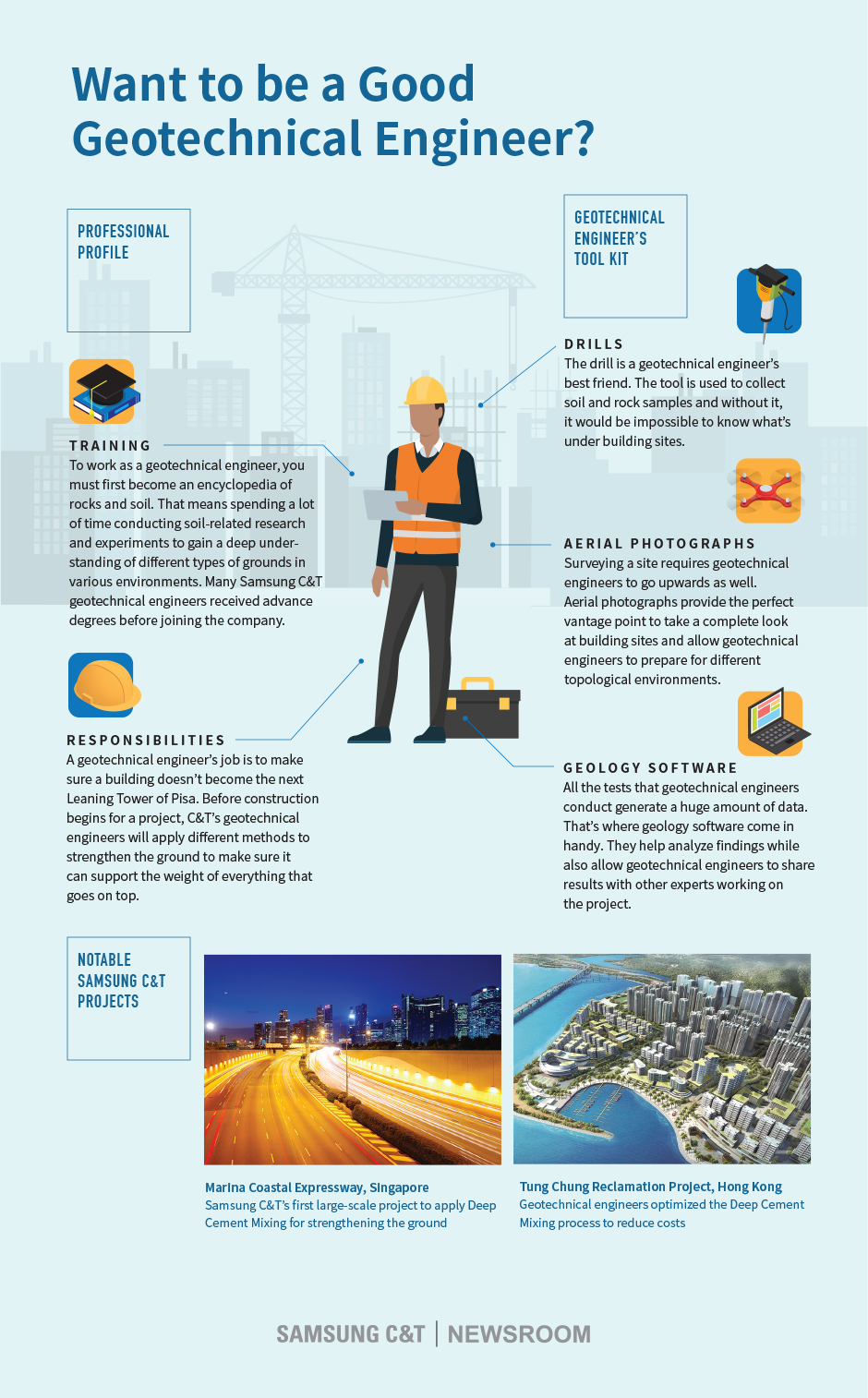Geotheta - Truths
Geotheta - Truths
Blog Article
The Definitive Guide for Geotheta
Table of ContentsUnknown Facts About GeothetaGetting My Geotheta To WorkThe Best Guide To GeothetaA Biased View of GeothetaRumored Buzz on Geotheta

They perform site examinations, gather samples, carry out research laboratory examinations, and assess information to examine the suitability of the ground for building and construction jobs - Tailings Engineer. Based upon their findings, geotechnical designers provide referrals for foundation layout, incline stability, keeping structures, and mitigation of geotechnical dangers. They collaborate with various other professionals, such as designers, architectural designers, and building and construction groups, to ensure that geotechnical considerations are integrated into the total task style and implementation
By assessing the behavior and residential properties of dirt and rock, they can identify potential geotechnical risks such as landslides, dirt settlement, or slope instability. Their know-how helps prevent failings or mishaps that might jeopardize lives and home. Here are some detailed responsibilities and duties of a geotechnical designer: Website Examination: Geotechnical engineers conduct website investigations to collect information on subsurface problems.
They interpret the data to recognize the residential properties and actions of the soil and rock, including their toughness, leaks in the structure, compaction characteristics, and groundwater conditions. Geotechnical Analysis and Layout: Geotechnical designers assess the data accumulated during site investigations to analyze the stability and suitability of the website for building and construction tasks. They do geotechnical computations and modeling to review factors such as bearing ability, negotiation, incline security, lateral planet stress, and groundwater flow.
The 8-Second Trick For Geotheta
Foundation Style: Geotechnical engineers play a critical duty in designing foundations that can securely support the designated framework. They analyze the soil problems and load demands to figure out the suitable foundation type, such as superficial foundations (e.g., footings), deep foundations (e.g (https://www.indiegogo.com/individuals/37984319)., stacks), or specialized methods like dirt improvement. They consider elements such as negotiation limitations, bearing capability, and soil-structure communication to create optimum structure layouts
They review building plans, monitor site tasks, and perform field assessments to confirm that the style referrals are complied with. If unexpected geotechnical issues arise, they assess the scenario and give recommendations for remediation or changes to the layout. Threat Analysis and Mitigation: Geotechnical engineers assess geotechnical dangers and threats connected with the task site, such as landslides, liquefaction, or dirt erosion.

Partnership and Communication: Geotechnical engineers function closely with various other professionals included in a task, such as engineers, structural engineers, and building and construction groups. Effective interaction and partnership are necessary to incorporate geotechnical considerations into the general task layout and building procedure. Geotechnical designers give technical proficiency, solution queries, and make sure that geotechnical requirements are fulfilled.
Facts About Geotheta Revealed
Right here are some types of geotechnical engineers: Structure Engineer: Foundation designers concentrate on making and assessing foundations for structures. They analyze the dirt conditions, tons needs, and site features to determine one of the most suitable structure type and style, such as shallow foundations, deep foundations, or specialized strategies like heap structures.
They examine the variables influencing slope stability, such as dirt residential or commercial properties, groundwater problems, and incline geometry, and establish methods to stop slope failures and reduce threats. Quake Engineer: Earthquake engineers concentrate on evaluating and creating structures to endure seismic forces. They assess the seismic risk of a site, examine soil liquefaction capacity, and establish seismic layout standards to ensure the security and strength of structures throughout earthquakes.
They carry out area screening, collect samples, and evaluate the gathered information to characterize the dirt buildings, geologic developments, and groundwater conditions at a site. Geotechnical Instrumentation Engineer: Geotechnical instrumentation designers concentrate on surveillance and gauging the habits of soil, rock, and frameworks. They set up and preserve instrumentation systems that monitor elements such as dirt negotiation, groundwater degrees, slope activities, and structural displacements to assess performance and supply early warnings of possible issues.
All About Geotheta
They perform examinations such as triaxial examinations, debt consolidation examinations, direct shear tests, and leaks in the structure examinations to collect data for geotechnical evaluation and layout. Geosynthetics Designer: Geosynthetics engineers concentrate on the style and application of geosynthetic materials, such as geotextiles, geogrids, and geomembranes. They make use of these products to boost dirt security, enhance inclines, provide drain remedies, and control erosion.
They often tend to be investigative individuals, which implies they're intellectual, introspective, and curious. They wonder, systematic, reasonable, analytical, and rational. Some of them are additionally social, meaning they're kind, charitable, participating, person, caring, useful, compassionate, skillful, and friendly. Does this seem like you? Take our cost-free profession examination to discover out if geotechnical engineer is one of your leading profession suits.
In the office environment, geotechnical engineers use specialized software application devices to perform estimations, develop layouts, and assess information. They prepare records, testimonial job requirements, interact with clients and team members, and coordinate job activities. The workplace setup offers a favorable atmosphere for research, evaluation, and collaboration with other specialists entailed in the job.
Everything about Geotheta
They often go to task websites to conduct website investigations, examine geotechnical conditions, and gather data for evaluation. These visits involve taking a trip to various areas, in some cases in remote or tough surfaces. Geotechnical designers might execute soil sampling, conduct examinations, and monitor building and construction tasks to guarantee that the geotechnical elements of the task are being implemented correctly.
Geotechnical designers likewise operate in specialized geotechnical labs. In these facilities, they carry out experiments, perform tests on soil and rock examples, and analyze the engineering homes of the materials. Geotechnical lab engineers function thoroughly in these atmospheres, managing screening tools, running instruments, and tape-recording data. Click Here They team up with various other laboratory personnel to make certain accurate and dependable screening outcomes.
Report this page